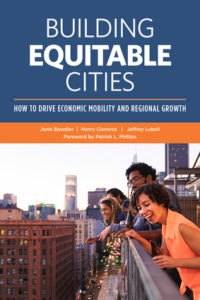In with Inclusivity, Out with Exclusivity: Building Equitable Cities, a New Book from the Urban Land Institute, Looks at Cities’ Efforts to Promote Greater Economic Mobility for All Residents
LOS ANGELES (October 26, 2017) – (RealEstateRama) — Building Equitable Cities, a new publication from the Urban Land Institute (ULI), explores how an increasing number of cities are focusing on providing economic mobility for a greater number of residents, with the ultimate goal of creating more inclusive, equitable environments in which to live, learn, work and thrive.

The book maintains that prioritizing economic mobility – which is defined as the ability of an individual to move up the economic ladder – is in the best interest of cities, in that cities are more likely to be successful if their residents are able to realize their full economic potential. Published with support from JPMorgan Chase & Co., it was released this week at ULI’s 2017 Fall Meeting in Los Angeles

“Engaging cities as leaders in a national strategy of combatting inequality is America’s best hope for ensuring that our historic experience of progressively building a fairer society continues, and that our ongoing quest for a more equitable society will drive our future,” says co-author Henry Cisneros, chairman of CityView in San Antonio, Texas, and former secretary of the U.S. Department of Housing and Urban Development.
The book points out that cities can best encourage greater economic mobility by using placed-based and people-based strategies to reduce income inequity, increase educational achievement and reduce racial and ethnic segregation:
- Placed-based strategies are designed to overcome the spatial inequities that constrain residents’ opportunities due to the zip code in which they reside. Such strategies strengthen struggling neighborhoods and improve the quality of services they provide; and they also expand the availability of affordable housing in areas that already provide high-quality services and a resource-rich environment.
- People-based strategies focus on services not tied to a specific neighborhood, but which are instead delivered to anyone who needs assistance, regardless of where they live. These strategies target systems for strengthening the education, workforce and financial outcomes that play a key role in helping individuals realize their full economic potential.
“ULI has traditionally focused its mission through the lens of market-based capitalism guided by intelligent public policy. And in this case, there is a strong business case for the subject of this book — equitable growth and inclusive prosperity,” says Global Chief Executive Officer Patrick L. Phillips. “ULI members are eager to find and advance innovative, practical solutions that harness the power of entrepreneurs, in a framework of strategic public investment, to help break the cycles of disadvantage that perpetuate inequality in our communities.”
“We know, now more than ever, the extent to which where you live impacts your economic circumstances,” says Janis Bowdler, Head of Community Development Initiatives, JPMorgan Chase & Co. “That’s why we must work together to ensure that the right policies are being put into place to give people the best chance possible at building a bright economic future for themselves and their families.”
Building Equitable Cities includes several case studies of different types of place-based strategies:
- Comprehensive community development, which is an approach to revitalization that addresses multiple challenges simultaneously to achieve the scale of change necessary to alter a neighborhood’s trajectory. Centennial Place and the Villages of East Lake in Atlanta, Georgia are offered as an example of this approach.
- Community development spurred by anchor institutions, which is an alternative approach that relies heavily on coordinated activities by one or more anchor institutions, such as a hospital or university. Greater University Circle Initiative in Cleveland, Ohio is profiled as an example of this approach.
- Community benefits agreements, which leverage large-scale private development to generate benefits for residents. Park East Redevelopment Compact in Milwaukee, Wisconsin is profiled for its successful use of an agreement.
- Efforts to reduce disparities in education outcomes by neighborhood, income, race and ethnicity, which involve the implementation of a citywide strategy to allocate resources and oversight to ensure that all schools meet the district’s standards for a high-quality education. Houston Independent School District in Houston, Texas is offered as an example of this approach.
- Efforts to increase affordable housing in more affluent areas, which includes providing incentives to build more mixed-income developments. Tysons Corner, Virginia is profiled as an example of this approach. The book also lists strategies for public acquisition of land in gentrifying areas for future affordable housing development, including the creation of acquisition funds, dedication of publicly owned land for affordable housing, and holding land for redevelopment. Sawmill Community Land Trust in Albuquerque, New Mexico is cited as an example of these options. Rental assistance programs are also discussed, such as the profile of the tenant aid program offered by the King County Housing Authority in King County, Washington.
Case studies of four people-based strategies are also explored:
- Comprehensive public education, including early childhood education, elementary and secondary education, and support for college studies and completion. StrivePartnership in Cincinnati and Northern Kentucky is profiled as an example of this strategy.
- Financial health. An initiative by the City of New York’s Office of Financial Empowerment to help low-income people save and manage money is cited as an example of this strategy.
- Workforce skills and development. Carreras en Salud in Chicago, which helps create career opportunities for low-income Latinos, is profiled as an example of this strategy.
- Small business development. A microfinance loan fund operated by LiftFund in San Antonio is cited as an example of providing support to small businesses in need of seed funding and expansion funding.
“America today is a more fair, open and upwardly mobile society than ever before. But modern forces such as globalism, technology, demographics and financial and economic shifts constantly create new realities,” the book states. “In an era of notable city comebacks and breakthrough urban growth, the nation can harness the momentum of its cities, communities and regions to ensure that we stay the course toward a more perfect union.”
Building Equitable Cities, (ISBN 9780-87420-410-0, hardback; ISBN 9780-87420-411-7, paperback) is available at the ULI Bookstore or for pre-order on Amazon. Hardback copies are $24.95; paperback copies are $14.95. ULI members receive a 25-percent discount.
Note to editors and reporters: To obtain a complimentary copy of Building Equitable Cities, contact Trish Riggs, 202-624-7086; ">.
About the Urban Land Institute
The Urban Land Institute is a nonprofit education and research institute supported by its members. Its mission is to provide leadership in the responsible use of land and in creating and sustaining thriving communities worldwide. Established in 1936, the institute has more than 40,000 members worldwide representing all aspects of land use and development disciplines. For more information, please visit uli.org or follow us on Twitter, Facebook, LinkedIn, and Instagram.
contact Trish Riggs, 202-624-7086;
















